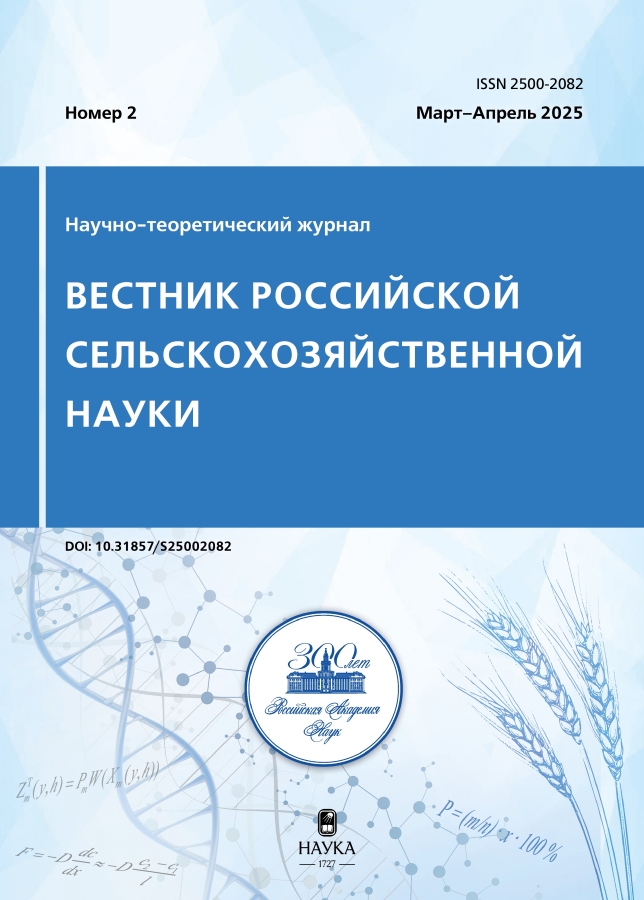Влияние метеоусловий и технологических приемов на формирование структурной основы урожая яровой пшеницы
- Авторы: Митрофанов Ю.И.1, Смирнова Ю.Д.1, Анциферова О.Н.1, Первушина Н.К.1
-
Учреждения:
- ФИЦ «Почвенный институт им. В.В. Докучаева»
- Выпуск: № 2 (2025)
- Страницы: 69-75
- Раздел: Земледелие
- URL: https://vietnamjournal.ru/2500-2082/article/view/684951
- DOI: https://doi.org/10.31857/S2500208225020149
- EDN: https://elibrary.ru/HVLDSS
- ID: 684951
Цитировать
Полный текст
Аннотация
Исследования проводили в 2011–2023 годах на агрополигоне Губино Всероссийского НИИ мелиорируемых земель (Тверская обл.). Цель работы – установить влияние погодных условий и отдельных технологических приемов на продуктивность и структуру урожая яровой пшеницы в условиях Нечерноземной зоны. Основные опыты проходили на осушаемом и переувлажняемом (не дренированном) участках с тремя вариантами технологий (экстенсивная – без удобрений, среднеинтенсивная – нормальная и интенсивная). В дополнительных опытах изучали эффективность щелевания почвы, гребнистой вспашки и гребнистого посева яровой пшеницы. Почва – дерново-подзолистая легкосуглинистая глееватая, окультуренная. Установлено, что на временно переувлажняемых землях основные направления интенсификации земледелия – их дренирование и применение удобрений. При совместном действии этих факторов урожайность яровой пшеницы возрастает более чем в два раза. Долевое участие минеральных удобрений в суммарном приросте урожая составило 77,9–84,9%, дренажа – 15,1–22,1%. Структурная модель биологической продуктивности яровой пшеницы с урожайностью 5,0 т/га представляет собой посев с плотностью стеблестоя 500 и более колосьев/ м2 при массе зерна в колосе более 1,0 г. Под влиянием неблагоприятных погодных условий количество стеблей с колосом снижалось на 25,9%, число зерен в колосе – 17,9, масса 1000 зерен – 30,4%. Применение удобрений оказывает большее влияние на увеличение числа зерен в колосе, агромелиоративные приемы обработки почвы и посева – на увеличение плотности продуктивного стеблестоя. Включение в технологические регистры возделывания яровой пшеницы агромелиоративных технологий и приемов обработки, направленных на улучшение агрофизического состояния почвы, следует рассматривать в качестве важного элемента их адаптации к агроэкологическим условиям осушаемых земель.
Ключевые слова
Полный текст
Об авторах
Юрий Иванович Митрофанов
ФИЦ «Почвенный институт им. В.В. Докучаева»
Автор, ответственный за переписку.
Email: vniimz@list.ru
Кандидат сельскохозяйственных наук
Россия, г. МоскваЮлия Дмитриевна Смирнова
ФИЦ «Почвенный институт им. В.В. Докучаева»
Email: vniimz@list.ru
Кандидат биологических наук
Россия, г. МоскваОльга Николаевна Анциферова
ФИЦ «Почвенный институт им. В.В. Докучаева»
Email: vniimz@list.ru
Кандидат сельскохозяйственных наук
Россия, г. МоскваНаталья Константиновна Первушина
ФИЦ «Почвенный институт им. В.В. Докучаева»
Email: vniimz@list.ru
Россия, г. Москва
Список литературы
- Балун О.В. Экологические режимы мелиорированных земель в Новгородской области // Аграрная наука Евро-Северо-Востока. 2024. № 25(3). С. 435–443. https://doi.org/10.30766/2072-9081.2024.25.3.435-443
- Векленко В.И., Солошенко Р.В., Долгополов А.В. Управление размерами и структурой посевов зерновых культур в Курской области // Вестник Курской государственной сельскохозяйственной академии. 2022. № 7. С. 232–238. Режим доступа: https://elibrary.ru/item.asp?id=49727226 EDN: MSFRLJ
- Демина Е.А., Роменская С.Е., Таранова Т.Ю., Чекмасова К.Ю. Влияние листовых подкормок жидкими комплексными удобрениями на урожайность и качество зерна яровой мягкой пшеницы // Земледелие. 2024. № 7. С. 25–26. https://doi.org/10.24412/0044-3913-2024-7-25-29
- Дробот В.А., Брусенцов А.С. Агромелиоративные приемы при поверхностной обработке почв // Год науки и технологий 2021: сб. тезисов по мат-лам Всерос. научно-практ. конф. Краснодар: Кубанский государственный аграрный университет имени И.Т. Трубилина, 2021. С. 252. Режим доступа: https://elibrary.ru/item.asp?id=46623388
- Журавлева Е.В., Милащенко Н.З., Сапожников С.Н., Трушкин С.В. Система увеличения производства высококачественного зерна пшеницы // Достижения науки и техники АПК. 2020. № 34(3). С. 7–10. https://doi.org/10.24411/0235-2451-2020-10301
- Кирюшин В.И. Концепция развития земледелия в Нечерноземье. СПб.: ООО «Квадро», 2020. 276 с. Режим доступа: https://elibrary.ru/rzgopo
- Кирюшин В.И. Управление плодородием почв и продуктивностью агроценозов в адаптивно-ландшафтных системах земледелия // Почвоведение. 2019. № 9. С. 1130–1139. https://doi.org/ 10.1134/S0032180X19070062
- Мальчиков П.Н., Мясникова М.Г. Вклады массы 1000 зерен и числа зерен в прирост урожайности в процессе селекции твердой пшеницы в Самарском НИИСХ // Достижения науки и техники АПК. 2024. № 38(9). С. 10–16. https://doi.org/10.53859/02352451_2024_38_9_10
- Митрофанов Ю.И., Анциферова О.Н. Гребнистый способ посева зерновых культур на осушаемых землях // Аграрная наука Евро-Северо-Востока. 2020. № 3. С. 301–312. https://doi.org/10.30766/2072-9081.2020.21.3.301-312
- Митрофанов Ю.И., Гуляев М.В., Пугачева Л.В., Первушина Н.К. Новый способ щелевания осушаемых почв // Международный сельскохозяйственный журнал. 2022. № 5. С. 541–545. https://doi.org/10.55186/25876740_2022_65_5_541
- Попов Ф.А., Козлова Л.М., Носкова Е.Н. Влияние ресурсосберегающих технологий возделывания зерновых культур на продуктивность полевого севооборота // Аграрный вестник Верхневолжья. 2019. № 2(27). С. 12–15. https://doi.org/10.35523/2307-5872-2019-27-2-12-15
- Gyrka A.D., Gasanova I.I., Gyrka T.V., Bokun O.I. Growth, development and productivity of winter wheat depending on the different soil tillage and sowing systems // The Scientific Journal Grain Crops. 2018. Vol. 2(1). PР. 88–93. https://doi.org/10.31867/2523-4544-2018-2-1-88-93
- Jaswal A., Prasad D., Singh A., Singh M. Fertilizers and Their Role in Plant Growth. India, Delhi: Bright Sky. (Publ.). 2022. 77 p. https://doi.org/10.22271/bs.book.30.
- Lucena Marinho J., Ricardo Silva S., de Batista Fonseca I.C. Technological quality of wheat grains and flour as affected by nitrogen fertilization and weather condition // Emirates journal of food and agriculture. 2023. Vol. 34(12). PР. 997–1011. https://doi.org/10.9755/ejfa.2022.v34.i12.2977
- Natroshvili D., Lomishvili M. Determining the optimal sowing frequency and sowing norm of cereal crops // American Scientific Research Journal for Engineering, Technology, and Sciences. 2021. Vol. 78(1). PР. 73–82. URL: https://www.researchgate.net/publication/350655164_Determining_the_Optimal_Sowing_Frequency_and_Sowing_Norm_of_Cereal_Crops
Дополнительные файлы













